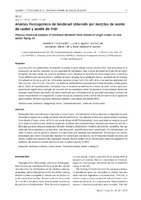Physico-chemical analysis of biodiesel obtained from blends of virgin castor oil and waste frying oil
Análisis físicoquímico de biodiesel obtenido por mezclas de aceite de castor y aceite de freír
| dc.rights.license | Licencia de Creative Commons Reconocimiento-NoComercial-CompartirIgual 4.0 Internacional (CC BY-NC-SA 4.0) | |
| dc.creator | Guimarães, Daniela Helena Pelegrine | |
| dc.creator | Aguirre, Lucas Romano | |
| dc.creator | Gonçalves Marques, Bruna Carolina | |
| dc.creator | Rosa, Maria T. M. G. | |
| dc.creator | Ribeiro dos Santos, Wallyson | |
| dc.date.accessioned | 2019-12-16T11:20:47Z | |
| dc.date.available | 2019-12-16T11:20:47Z | |
| dc.date.issued | 2019-11-04 | |
| dc.identifier.citation | Guimarães, D. H. P., Aguirre, L. R., Gonçalves, B. C. M., Rosa, M. T. M. G., y Santos, W. R. (2019). Physico-chemical analysis of biodiesel obtained from blends of virgin castor oil and waste frying oil. Revista de Ciencia y Tecnología (RECyT). Posadas (Misiones): UNaM. FCEQyN; 32(1), 11-15. | |
| dc.identifier.issn | 1851-7587 | |
| dc.identifier.other | RCyT-004 | |
| dc.identifier.uri | https://hdl.handle.net/20.500.12219/2164 | |
| dc.identifier.uri | https://doi.org/10.36995/j.recyt.2019.32.002 | |
| dc.identifier.uri | https://www.fceqyn.unam.edu.ar/recyt/index.php/recyt/article/view/258 | |
| dc.description | Fil: Guimarães, Daniela Helena Pelegrine. University of Sao Paulo. Lorena Engineering School; Brasil. | |
| dc.description | Fil: Aguirre, Lucas Romano. University of Sao Paulo. Lorena Engineering School; Brasil. | |
| dc.description | Fil: Gonçalves Marques, Bruna Carolina. University Center Teresa D’Ávila; Brasil. | |
| dc.description | Fil: Rosa, Maria T. M. G. Mackenzie Presbyterian University; Brasil. | |
| dc.description | Fil: Ribeiro dos Santos, Wallyson. University of Sao Paulo. Lorena Engineering School; Brasil. | |
| dc.description.abstract | Renewable fuels production got a big boost in recent years. One alternative is the production of vegetable oils with the ability to replace all or partly the diesel fuel derived from oil. The objective of this work was to produce biodiesel from blends of virgin castor oil (VCO) and waste frying oil (WFO) from ethylic route and alkaline catalysis as well as to study the physical and chemical properties. Biodiesel was obtained from 5 different raw materials: VCO (B1), WFO (B2) and three different blends (B3: 50%VCO+50%WFO; B4:25%VCO+75%WFO; B5:75%VCO+25%WFO). The raw materials were evaluated by acidity level, free fatty acids, saponification index and density. For the biodiesel, the index of iodine, cetane, glycerin, absence of triglycerides and rheology was determined. According to the results, all samples were within the specified standard for iodine index and density, but B1 biodiesel showed viscosity and cetane number not allowed in the legislation. Despite the fact thatB4 and B5 results were within the legislation for biodiesel, B4 would be a better alternative due to higher quantity of WFO. | en |
| dc.description.abstract | La producción de combustibles renovables ha tenido un gran impulso en los últimos años. Una alternativa es la producción de aceites vegetales con la capacidad de reemplazar todo o parte del diesel derivado del petróleo. El objetivo de este trabajo fue producir biodiesel a partir de mezclas de aceite de ricino virgen (VCO) y aceite de fritura (WFO) a partir de ruta etílica y catálisis alcalina y estudiar las propiedades físicas y químicas de los mismos. El biodiesel se obtuvo a partir de 5 diferentes materias primas: VCO (B1), WFO (B2) y tres mezclas diferentes (B3: 50% VCO; B4: 25% VCO; B5: 75% VCO). Las materias primas fueron evaluadas por el nivel de acidez, ácidos grasos libres, índice de saponificación y densidad. Para el biodiesel se determinó el índice de yodo, cetano, glicerina, ausencia de triglicéridos y reología. De acuerdo con los resultados, todas las muestras se encontraron dentro del estándar especificado para índice de yodo y densidad, pero el biodiesel de B1 presentó viscosidad y número de cetano no permitidos en la legislación. A pesar de que los resultados de B4 y B5 se ubicaron dentro de la legislación para biodiesel, B4 sería una mejor alternativa debido a una mayor cantidad de WFO. | es_AR |
| dc.format | application/pdf | |
| dc.language.iso | eng | en |
| dc.publisher | Universidad Nacional de Misiones. Facultad de Ciencias Exactas, Químicas y Naturales. Secretaria de Investigación y Posgrado | es_AR |
| dc.rights.uri | http://creativecommons.org/licenses/by-nc/4.0/ | |
| dc.source | Revista de Ciencia y Tecnología (Misiones), 11-2019; 32(1): pp. 11-15 https://www.fceqyn.unam.edu.ar/recyt/index.php/recyt | |
| dc.subject | Biodiesel | en |
| dc.subject | Oilseeds | en |
| dc.subject | Castor beans | en |
| dc.subject | Transesterification | en |
| dc.subject | Waste cooking oil | en |
| dc.subject | Biodiesel | es_AR |
| dc.subject | Oleaginosas | es_AR |
| dc.subject | Ricino | es_AR |
| dc.subject | Transesterificación | es_AR |
| dc.subject | Aceite de cocina usado | es_AR |
| dc.title | Physico-chemical analysis of biodiesel obtained from blends of virgin castor oil and waste frying oil | en |
| dc.title | Análisis físicoquímico de biodiesel obtenido por mezclas de aceite de castor y aceite de freír | es_AR |
| dc.type | info:eu-repo/semantics/article | |
| dc.type | info:ar-repo/semantics/artículo | |
| dc.type | info:eu-repo/semantics/publishedVersion |
Files in this item
This item appears in the following Collection(s)
-
Revista de Ciencia y Tecnología (RECyT) [43]
La Revista de Ciencia y Tecnología (RECyT) publica artículos originales que representan una contribución para el desarrollo científico-tecnológico. Colección correspondiente a las áreas de incumbencia: Ingeniería - Tecnología - Informática - Educación Científica y Tecnológica.




